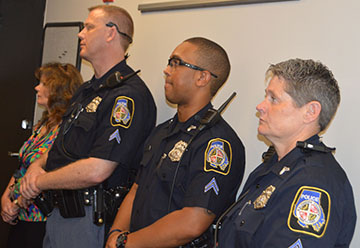Baltimore County has completed equipping all uniformed police officers with body-worn cameras by its expedited Sept. 30 timeline and within budget, county officials announced.
Deployment of the audio visual recording devices began in July 2016, with 10 officers from each of the 10 precincts receiving a camera the first day the program took effect, and then 10 officers a week for the next 15 weeks were trained and equipped with a camera. Initially, the second phase was to begin in July 2017 and deploy cameras to 1,285 officers, with 1,435 of the 1,900 officers on the police force to be trained by the end of December.
However, last October, County Executive Kevin Kamenetz announced he was accelerating full implementation of the body camera program by 14 months by increasing overtime funds necessary to speed up officer training.
The announcement came two months after the Aug. 1, 2016 fatal police shooting of Korryn Gaines, a 22-year-old mother of two in her Randallstown apartment with her young son present. Police said none of the officers directly involved in the situation was wearing a camera. A month later, a 21-year-old man died after a fight with police in Middle River. A police shooting in December of a Pikesville man at his home was recorded by two officers wearing body cameras. That footage was released to the public. Other recordings of police-involved shootings and confrontations have been withheld.
According to the policy, officers are to test the devices before they begin their shifts and report any malfunctions. The officers are to notify individuals when they are being recorded, and activate the cameras for enforcement or investigative activity, such as traffic stops, searches, pursuits, arrests, field interviews, stop and frisk situations, and other activities of a potentially confrontational nature. They must also record emergency vehicle operations and custodial transports.
Officers may use their department issued body worn cameras while working authorized secondary employment in uniform. The Precinct 8 officer working a side job at Giant Foods in Catonsville fatally shot a suspected shoplifter on Aug. 1 while he was driving away in his vehicle. He was not wearing a camera.
Kamenetz applauded the program as a “valuable tool in strengthening the relationship of trust and understanding with the community.” He stated, “By objectively capturing the actions of officers in the field, they improve transparency and help reduce complaints against officers and facilitate more efficient, effective prosecutions.”
Police Chief Terrence Sheridan said in a statement, “The body-worn camera program has already proven helpful in a number of arrests and prosecutions.”
The first five years of the program will cost $7.1 million for equipment, maintenance and storage. The annual cost is estimated at $1.6 million, including ongoing officer training and the cost of hiring at least 21 additional full-time personnel to manage the program.
So far, the county has processed more than 250,000 recordings, including 45,000 hours of video, and has transferred more than 79,000 files to the States Attorney’s Office (67,000 videos and 11,800 photographs).
Body camera video is treated the same as any other public record, subject to release under the Maryland Public Information Act and other relevant laws, according to county officials. Video footage of incidents also assists in resolving investigations by insurance companies, attorneys, the Motor Vehicle Administration and others through the Maryland Public Information Act.

